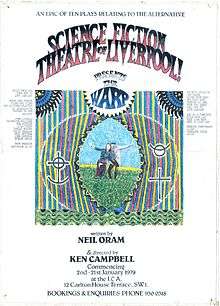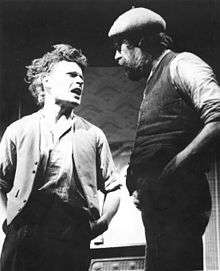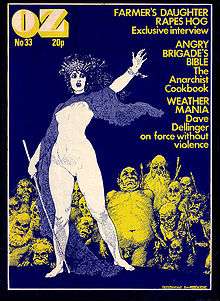Neil Oram
Neil Oram is a British musician, poet, artist and playwright, best known as the author of The Warp, a 10 play cycle, directed by Ken Campbell.

Family
Oram is a Celt born in Torquay on 2 January 1938. His father, Bob Oram, was a sportsman and musician, a champion cyclist who played the fiddle and mandolin. He was also a witty cartoonist and an accomplished conjurer. In the Second World War Bob Oram worked with Frank Whittle on creating the first jet engine. He was an expert gardener and later worked managing a large flower shop. Above all Oram’s father was a warm-hearted and spiritual teacher who as often away during the war years. By contrast, Oram’s mother was possessed of a furious temper and many times beat the three to five year old Neil with a stick until he fainted, showering him with love when he came to telling him he would never find another woman who would love him the way she did. This upbringing led Oram to learn to find spiritual strength in himself and pleasure in solitude. Oram has three grandchildren, the eldest of whom, Matthew, is studying Geography at Durham University.
Early Life & Influences
Oram was educated at Torquay Boys' Grammar School where the Headmaster - ‘Soapy Joe’ Harmer - pronounced that Oram was the worst behaved boy in the whole history of the school. This was after Oram had organized a couple of mass rebellions and refused to be caned. In his second year a fellow 'rebel' pupil, Paul Eva, introduced Oram to modern jazz. Oram has recounted how the moment Eva played him Gerry Mulligan's ‘Walking Shoes’, instantly his life was changed. Soon, via a primitive record player and earphones in his father's shed, Oram discovered the art of Dave Brubeck, Miles Davis, Thelonious Monk, Charlie Parker, Dizzy Gillespie, Stan Getz and Charlie Mingus. New very sharp modern clothes were tailored and worn at the modern jazz gigs held in the Torquay Town Hall where combos like The Tony Kinsey Trio and The Don Rendell Sextet played.
Soho, Jazz, Art & Poetry
In 1956 Oram traveled to Africa where he met musician Mike Gibbs in Salisbury, (now Harare). He played double bass in the Mike Gibbs Quintet with Gibbs on piano, vibes and trombone. A post-concert epiphany where a voice repeatedly told him "Je suis un poet!" led him to take up writing.[1] Oram returned to Britain in 1958 where he ran a jazz café called The House of Sam Widges at 8 D'Arblay Street in Soho, London.[2] The café was known for its jukebox which only had modern jazz records. It attracted many of the top London musicians. Ronnie Scott, Tubby Hayes, Graham Bond, Dave Tomlin and Bobby Wellins were frequent customers, occasionally enjoying a bowl of spaghetti bolognese crafted by Oram. Downstairs was a club/performance space called 'The Pad'.
Oram was now writing poetry, giving readings and painting large abstract jazz inspired paintings. In 1960 he opened The Mingus art gallery in Marshall Street, Soho where abstract paintings by O. G. Bradbury, George Popperwell, Jaime Manzano, Tony Shiels and William Morris the American beat poet/action painter could be seen. Morris's huge, jazz paintings were executed in The Pad to the vibrant sounds of the Graham Bond Quartet, then carried round the corner and hung up wet in The Mingus.[3]
-_Neil_Oram.jpg)
Oram’s published poems can be found in ‘Children of Albion’ (Penguin 1968), ‘Words-re-arranged’, (privately printed 1970), ‘Past The Antique Pain’ (Zum Zum 1974), ‘Beauty’s Shit’ (Zum Zum 1976), ‘The Golden Forgotten’ (Great Works 1977), ‘Yes To The Fresh’ (Zum Zum 1995).
Oram contributed to the Poetry Review,[4] edited by Eric Mottram, a mainstay of the modernist-inspired British Poetry Revival of the 1960s and 1970s.
Oram's poems & other writings can be found in underground magazines from the late 1950s onwards, like Night Scene published by Lee Harwood, and International Times (IT)[5] A select collection of poems drawn from 56 years of poetry, The Rain Stands Tall, was published in 2015 by Barncott Press.
Oram has over a long period painted abstracts, mostly not shown in public. The paintings include a series of twenty geometric images, the Diamond Series, painted over two decades.
Spiritual Life
After Oram closed The Mingus he lived in Paris where in 1961 he attended talks given by Krishnamurti. Two years later Oram met Krishnamurti personally in London. At this meeting Krishnamurti asked Oram to organise a small discussion group to meet with him. Oram complied, leading to a number of further meetings with the spiritual teacher.
In this same year 1963 Oram became a member of The Study Society founded by Peter Ouspensky where he was introduced to Sufi and Advaita teachings, Dervish Turning, Transcendental Meditation and The Movements designed by George Gurdjieff.
In 1965 Oram moved with his wife and baby daughter to Haworth - the village where the Brontë family lived. While meditating near the Brontë graveyard, in another epiphany, he was instructed to found "a center where a person could give birth to their true Self. A spiritual maternity hospital without dogma." Within 3 weeks Oram and family upped roots, and soon, after further mysterious guidance, settled on 100 acres of abandoned land overlooking Loch Ness. He has lived there since he arrived in 1968, directing the spiritual maternity hospital, and crofting the land, growing wheat, oats, vegetables, and learning to make natural dyes and weave carpets. Apart from the hospital, the site now also hosts a thriving pottery and cafe.

In 1977 Oram had meetings with Rajneesh in Poona which he later recorded in his ten play cycle The Warp,
In 1983/84 Oram stayed in the Ashram of Haidakhan Babaji in India, which is recorded in his play The Friends of Deception written in 2012/13.
The Warp
The Warp's hero is called Phil Masters named after the blind poet Philip Bourke Marston who lived from 1850 to 1887. The play traces the hero’s many previous lives over a period of thousands of years. The Warp appears in the Guinness Book of Records as being the longest play ever performed.[6][7] Lasting 22 hours when performed in full, the Phil Masters character is required on stage for all but five minutes, making it one of the most demanding acting roles ever created.
The first performance of the Warp (Warp 1, The Storm's Howling through Tiflis) opened at London's ICA on 2 January 1979, the author's birthday. For the first two weeks the performances were of one play per night. Then due to the enthusiasm created there were three full non-stop 'marathon' performances of all 10 plays, which were also filmed. Performers included Russell Denton (in the lead), Jim Broadbent, Bill Nighy, Maria Moustaka, Stephen Lorne-Williams, Neil Cunningham, Richard Hope and Pat Donovan. In order that Denton be sufficiently rested to do the marathons, where he would be on stage for 22 hours, Oram was himself called upon to step up and perform the lead in a number of the plays. The ICA performance was documented by the BBC in their Arena arts TV series.[8]

At the 1979 Edinburgh Festival the abandoned, dilapidated Regent Cinema was taken over by The Warp troupe who put on five 24-hour marathon performances or “cycles”.[9] This was followed with one performance at Hebden Bridge in Yorkshire.
Five further marathon performances followed at the Roundhouse in London in November 1979, also directed by Campbell.
In 1980 Oram was 'resident playwright' at the Everyman Theatre in Liverpool where The Warp ran for ten weeks. While there Oram wrote an 11th Warp play entitled Chameleon Blue.[10]
In 1980-82 The Warp was adapted by director Werner Nekes for a film called Uliisses,[11] shot in Germany with the Warp cast. It was screened at the 1982 London Film Festival.[12] In 1984 the film was awarded Best Film at the German Film Critics Association Awards.[13]
The Warp was subsequently turned into a three volume novel by Oram, published by Sphere Books.
The Warp DVD, a video of the full 18-hour 1979 ICA production is available directly from Oram [14]
In the 1990s there were a number of productions of The Warp directed by Ken Campbell's daughter Daisy Campbell.
In the late 1990s the play was staged at The Drome nightclub under the arches of the London Bridge as part of a rave called The Warp Experience that ran for 9 events.
Authorship confusion
Obituaries on Ken Campbell in The Telegraph[15] and The Guardian[16] say that Ken "wrote" The Warp or "co-wrote" The Warp with Neil Oram. However other reviews[17] and articles[18] plus all known publicity material acknowledges Neil Oram as being the sole author. It seems clear that Ken Campbell directed, but never wrote a word of the Warp. There is no evidence that he ever claimed that he did.
According to Oram[19] the true story behind the writing of The Warp is as follows: Ken Campbell "inspired" him to write The Warp as a play after, at the ICA in 1978, Campbell heard Oram give a one-man performance of stories from his life. Campbell suggested dramatization and offered to direct the result. Commissioned by the ICA, and funded by the Arts Council, Oram set to work. A brief attempt at collaboration, with Campbell typing up the script, proved impractical. Oram then wrote the entire ten play cycle, by hand, by himself in Butleigh, Somerset.
Bibliography
- Children of Albion (Penguin, 1968)
- Words-re-arranged (Privately printed, 1970)
- Past The Antique Pain (Zum Zum,, 1974)
- Beauty’s Shit (Zum Zum, 1976)
- The Golden Forgotten (Great Works, 1977)
- Yes To The Fresh (Zum Zum, 1995)
- The Warp 1: The Storm's Howling Through Tiflis (Sphere)
- The Warp 2: Lemmings on the Edge (Sphere)
- The Warp 3: The Balustrade Paradox (Sphere, 1982).
- Spy For Love (Oberon, 2002)
- Inside Out (Barncott Press 2013)
- The Friends of Deception (Barncott Press, 2013)
- ' 'The Rain Stands Tall Collected Poems (Barncott Press, 2015)
Filmography
- Uliisses (1982) (director, Werner Nekes) (35mm, 94 mins)
References
- Warp 1, The Storm's Howling through Tiflis, page 40.
- Lee Harwood Not The Whole Story] Photo + interview, Chapter 2, page 32. Shearsman Books, Exeter (2008).
- Interview with Neil Oram 2013
- Vol. 66/2 (1976). Contributors to the Poetry Review 1972-1977.
- The Energetic Eighties, Neil Oram, International Times, 1980 Vol 5 No 5.
- Ian Shuttleworth. "THE WARP: Introduction". Compulink.co.uk. Retrieved 16 August 2009.
- "World's longest play. Neil Oram The Warp". Thelongestlistofthelongeststuffatthelongestdomainnameatlonglast.com. Retrieved 16 August 2009.
- "The Warp". Arena. BBC. 1979. Retrieved 11 November 2013.
- 'NO PROBLEM' Arts Council film by Ian Johnson, partly shot in The Regent during rehearsal for The Warp
- Poster for Chameleon Blue
- Neil Oram on IMDb
- BFI.org
- https://www.imdb.com/event/ev0000787/1984
- http://www.warp-experience.com/warpDVD.html
- Ken Campbell obituary, Daily Telegraph, 1 September 1980.
- Ken Campbell obituary, The Guardian, 1 September 1980.
- The Warp, Michael Coveney, Financial Times, 22 January 1979.
- The Man With The Warp Mind, Philip Key, Liverpool Daily Post, 15 November 1980.
- Introduction to Spy For Love by Neil Oram (Oberon 2002)
